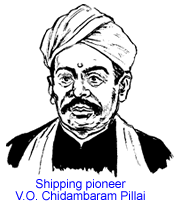
Dimdima
Online Children's Magazine from India

Dimdima
Online Children's Magazine from India
| Swadeshi Enterprise |
|
|
Small scale industries flourished Swadeshi match box, soap, ink and nibs were in
demand. Use of Swadeshi nibs was a real test of patriotism, due to their poor quality! Swadeshi paper, candle
and pencils were manufactured.
was a real test of patriotism, due to their poor quality! Swadeshi paper, candle
and pencils were manufactured.
The Sibpur Iron Works was functioning from 1867. Another company started
manufacturing Iron-safes, Small factories sprans up to manufacture buckets which
were until then being imported.
Riding the wave of Swadeshi sentiment Tata Iron and Steel raised an initial
capital 2.5 crores within three weeks of publication of the prospectus on 27th
August 1907. It was Pramathanath Bose who had discovered and drawn the attention
of the Tatas to the rich iron ore deposit of Gurumahishini as a result of which
the site of the plant was shifted from central provinces to Sakchi, the
Jameshdpur of today. Tata Iron and Steels continues to flourish today as a
magnificient living menument for the swadeshi spirit which animated the country
at the beginning of this century.
By 1907-8 the emphasis in Swadeshi efforts made inroads to banking, insurance
and inland trade.
The Swadeshi enterprise was not limited to Bengal alone. Like the monsoon winds
the Swadeshi breeze blew across the country. For cotton mills in western India
and Southern India the Swadeshi came as a shot in the arm. The imported cotton
piece-goods decreased by three crores of yards, the impact of foreign shoes fell
by 75% and of cigarettes by 50%.
One of the English firms in Calcutta cabled this message to the Parent Company
in England: "Boycott result is disastrous. Boots are not salable... hosiery,
hats and waist bangles are also affected." The London Times noted with concern
that the value of cotton textile exported to India fell by 23.7%. New mills
started coming up to meet demand for swadeshi cloth in India.
With the Swadeshi wind to back, Chindambaram Pillai started Swadeshi Nangation
Compamy to run ships between ....... and .... and earned the title Kappal-Otiya-Tamilan the Tamil who ran the Kappal the ships. His close associates Subramania Bharati sang songs in praise of Swadeshi. Subramania Aiyar, Anand Charlu and T.M. Nair in the South, Tilak, Paranjape, V.G. Bijapurkar in the West, Lala Lajpatrai, Munshi Ram (later, Swami Shraddananda), Pandit Chandrika Dutt in North and many others championed the cause of Swadeshi and the Bengal model was repeated in different parts of the country.
Swadeshi was no longer promotion of Indian Industry. Swadeshi came to be looked
upon as love for everything Indian.
Dimdima is the Sanskrit word for ‘drumbeat’. In olden days, victory in battle was heralded by the beat of drums or any important news to be conveyed to the people used to be accompanied with drumbeats.
Bharatiya Vidya Bhavan
K. M Munshi Marg,
Chowpatty, Mumbai - 400 007
email : editor@dimdima.com
Bharatiya Vidya Bhavan
505, Sane Guruji Marg,
Tardeo, Mumbai - 400 034
email : promo@dimdima.com
Dimdima.com, the Children's Website of Bharatiya Vidya Bhavan launched in 2000 and came out with a Printed version of Dimdima Magazine in 2004. At present the Printed Version have more than 35,000 subscribers from India and Abroad.